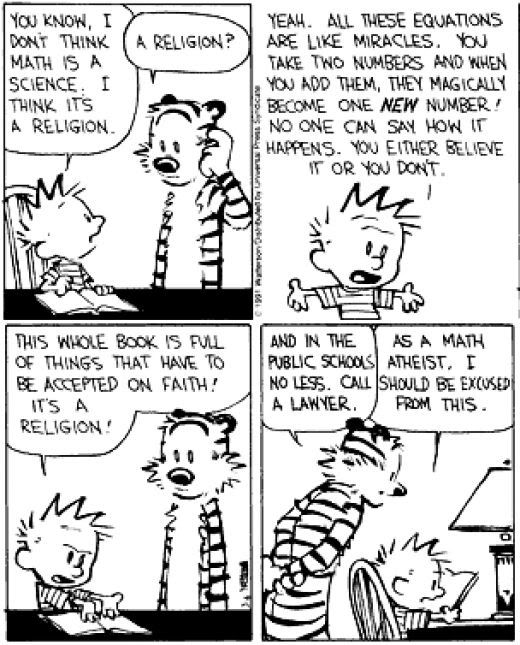 Every teacher and student knows (and probably uses) the excuses. “My dog ate my homework.” “I got sick, but then I was better when I woke up, so my mom made me come to school.” Or, the most common in the 21st century, “My computer crashed.” Every child wants to avoid homework. It is a natural part of life to want to avoid work as much as possible. This strip of Calvin and Hobbes, known to fans as “Math Atheist,” is a parody of childhood laziness and a parent’s sarcastic response. The argument made is simple. Kids will be kids; adults will be adults. Through devices such as anthropomorphism, simplicity, and rhetoric “Math Atheist” presents us with universal appeals to logos which eventually get turned into the expected appeals to pathos.
Every teacher and student knows (and probably uses) the excuses. “My dog ate my homework.” “I got sick, but then I was better when I woke up, so my mom made me come to school.” Or, the most common in the 21st century, “My computer crashed.” Every child wants to avoid homework. It is a natural part of life to want to avoid work as much as possible. This strip of Calvin and Hobbes, known to fans as “Math Atheist,” is a parody of childhood laziness and a parent’s sarcastic response. The argument made is simple. Kids will be kids; adults will be adults. Through devices such as anthropomorphism, simplicity, and rhetoric “Math Atheist” presents us with universal appeals to logos which eventually get turned into the expected appeals to pathos.Calvin and Hobbes was one of the most popular comic strips of the late 1980s and early 1990s. It appeared in thousands of newspapers across the nation and was read by millions. It has remained popular to this day through re-prints and book collections. In other words, almost everyone knows what the strip Calvin and Hobbes is and understands it is supposed to be a funny, sarcastic newspaper comic strip. Thus, the audience comes to “Math Atheist” with a certain set of expectations. It is supposed to funny, an expectation which Bill Watterson, the artist, understands. In “Math Atheist,” however, those expectations are not fulfilled until the very last panel.
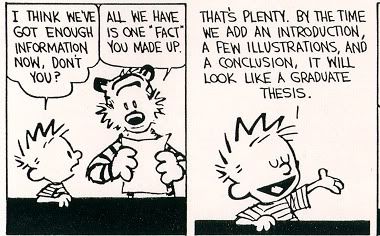
The rhetoric of “Math Atheist” makes the main argument, while the various technical elements discussed later amplify and universalize this message. The scene starts out simply enough with a boy (Calvin) doing his math homework at his desk. This is a recurring theme in Calvin and Hobbes, and the audience should expect Calvin to simply refuse to do his homework and play outside, as he does so many other times. However, this time Watterson defies the norm of Calvin’s behavior and instead launches into an impassioned, logical (though flawed) speech about how math is a religion. Math is not science but religion, Calvin claims, and there is a math “god” performing miracles. You either believe in math or you don’t. You have to take it by faith, and that makes it a religion. He appears completely convinced of his own position. Through these appeals to logos, “Math Atheist” defies the conventions we have come to expect from Calvin and Hobbes.
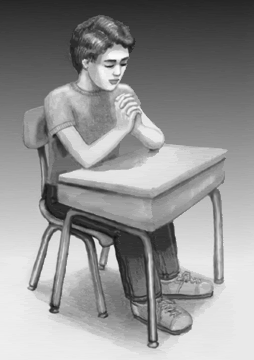
In the fourth panel comes the reveal: “As a math atheist, I should be excused from this.” The whole speech and line of reasoning is an excuse to get out of his homework. As one person said when he saw this comic, it is “The greatest ‘my dog ate my homework’ of all time.” He has created a preposterous religious system with math as a god and declared himself a math atheist just to get out of doing the math in the first place. Through this, “Math Atheist” uses the logical fallacy of red herring (bringing up unrelated issues in order to distract the opposition from the topic at hand) in order to create the argument of the piece. In other words, Watterson intentionally used flawed logic and false appeals to logos in order to set up his parody of little children and his overall appeal to pathos.
Also important to the argument of “Math Atheist” is the tiger’s (Hobbes) response to the speech. The sarcastic comment about getting a lawyer with Hobbes’ neutral (rather than convinced) facial expression gives Hobbes the role of parent. Throughout the years Watterson wrote Calvin and Hobbes, Hobbes always played the role of sensible counterpart to Calvin’s antics. As Calvin’s role is parodying a child’s avoiding homework, Hobbes is parodying a parent’s role in the situation. While it may appear Hobbes is agreeing with Calvin, a close examination of Hobbes’ facial expression (when compared to his facial expressions in other strips), it becomes clear Hobbes is actually saying Calvin’s argument is ridiculous. Hobbes is basically saying, “Yeah right.” “Math Atheist” makes an undeniable argument of parent and child. However, in order for the argument to be universally understood, it must be universally understandable. Several key technical elements universalize and emphasize this argument
First, and most obviously, “Math Atheist” employs anthropomorphism. In short, anthropomorphism is applying human characteristics to animals. It is obvious the tiger (Hobbes) is not a human, yet he
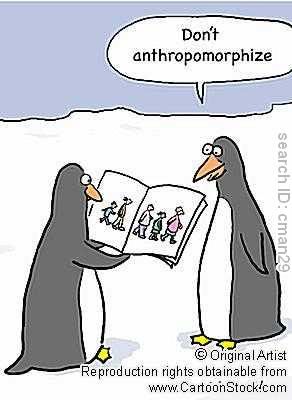 talks, thinks, reasons, and understands the concept of separation of church and state just as well as the boy (Calvin) does. “Math Atheist” accomplishes two things by employing this device. First, it forces the audience to suspend disbelief. The audience knows stuffed tigers cannot talk in real life. However, by showing a stuffed tiger doing just that “Math Atheist” forces the audience to put aside its preconceived notions of the world. This allows the audience to accept that a six year old understands the nuances of the separation of church and state. This suspension of disbelief gives the audience accessibility to the subject matter. Second, the use of anthropomorphism gives the audience a way to relate to Calvin and Hobbes. Almost every child had a stuffed animal or doll as a “pet.” Therefore, by using anthropomorphism, "Math Atheist" both allows the audience to both believe the scene and connect with the dialogue.
talks, thinks, reasons, and understands the concept of separation of church and state just as well as the boy (Calvin) does. “Math Atheist” accomplishes two things by employing this device. First, it forces the audience to suspend disbelief. The audience knows stuffed tigers cannot talk in real life. However, by showing a stuffed tiger doing just that “Math Atheist” forces the audience to put aside its preconceived notions of the world. This allows the audience to accept that a six year old understands the nuances of the separation of church and state. This suspension of disbelief gives the audience accessibility to the subject matter. Second, the use of anthropomorphism gives the audience a way to relate to Calvin and Hobbes. Almost every child had a stuffed animal or doll as a “pet.” Therefore, by using anthropomorphism, "Math Atheist" both allows the audience to both believe the scene and connect with the dialogue.The second element “Math Atheist” employs is simplicity. Except for the lamp in the fourth frame, there are no extraneous illustrations. Even the chair “disappears” during Calvin’s monologue in the third panel. The table in the foreground in the first panel also has no properties except as a visual “spine” for the panel. This simplicity of artistry gives adds to the universalism of the strip in two ways. First, the lack of “artistic clutter” amplifies the message of the strip. Any extra drawings would serve no purpose than distract the reader from the message. Second, the large empty spaces give the audience a blank slate upon which to write its own interpretation.
In addition to the lack of background and foreground, the characters’ features are drawn very simply. Calvin’s face consists of an incomplete outline, a black spot for his mout
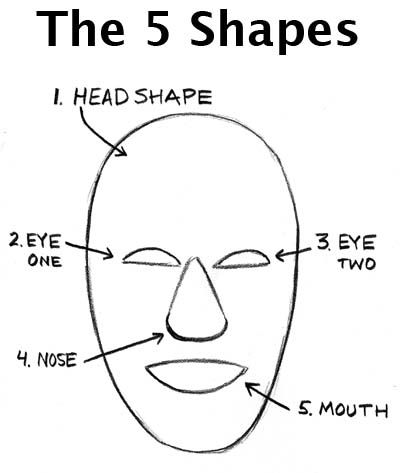 h (with a tongue), simple eyes, and lines for his forehead and eyebrows. As Scott McCloud states in The Vocabulary of Comics, “When we abstract an image through cartooning we’re not so much eliminating details as focusing on specific details.” The abstraction of Calvin’s face allows the audience to focus on his emotion and facial expressions. Like a debater passionately arguing his point, Calvin raises his eyebrows as he pleads his case for separation of the math religion and state. Like a distant audience member, Hobbes wears a quizzical expression as Calvin lays a preposterous argument. The simplistic and unrealistic nature of the drawings allow the audience to access and focus on these emotions and amplifies the logos and pathos of “Math Atheist.”
h (with a tongue), simple eyes, and lines for his forehead and eyebrows. As Scott McCloud states in The Vocabulary of Comics, “When we abstract an image through cartooning we’re not so much eliminating details as focusing on specific details.” The abstraction of Calvin’s face allows the audience to focus on his emotion and facial expressions. Like a debater passionately arguing his point, Calvin raises his eyebrows as he pleads his case for separation of the math religion and state. Like a distant audience member, Hobbes wears a quizzical expression as Calvin lays a preposterous argument. The simplistic and unrealistic nature of the drawings allow the audience to access and focus on these emotions and amplifies the logos and pathos of “Math Atheist.”The rhetoric of “Math Atheist” employs an impassioned speech riddled with logical fallacies. This speech has a surprisingly simple conclusion: “I shouldn’t have to do my homework.” Through the sarcastic response of the parent figure, we see the intended argument of a parody of a modern American family. In order to emphasis this argument and make it accessible to the general public, such devises as anthropomorphism and simplicity are used. The end argument is clear and unmistakable: Kids will be kids. And parents will be parents. There is no use in escaping natural human laziness, "Math Atheist" says. The only way to overcome it is to simply accept the fact that work is part of existance.
No comments:
Post a Comment